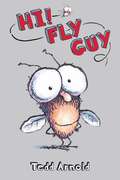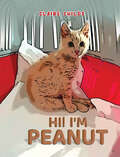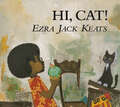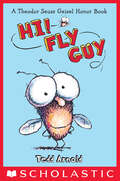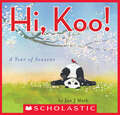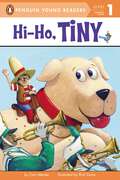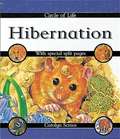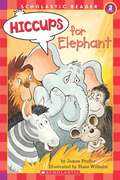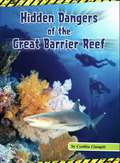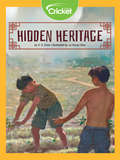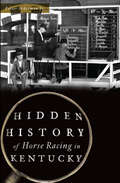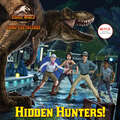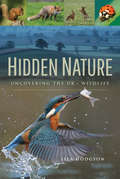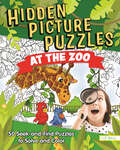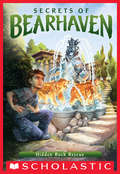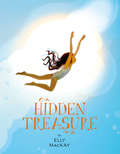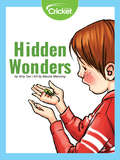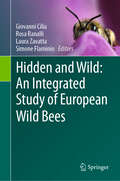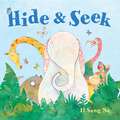- Table View
- List View
Hey, You're Not the Easter Bunny!
by Ethan T. BerlinWhen the Easter Bunny needs a last-minute substitution, an unlikely hero steps in. Will anyone notice that the Easter Bunny is...an ostrich?!The Easter Bunny is hard at work hiding eggs for an Easer Egg Hunt. But when he needs to dash back to Easter Island to get more eggs, an unlikely hero—an ostrich!—has to put on the bunny ears. She hops into the yard with basket in tow, and is met by a little girl who is eager to start the hunt for eggs. Will this ostrich be able to save Easter? Or will this little girl realize… “Hey! You’re NOT the Easter Bunny!”Readers of all ages are sure to laugh out loud to this hilarious Easter story, and will love being in on the joke as this ostrich does her best to convince everyone that she's the Easter Bunny, from hopping on a trampoline to laying her own eggs. Full of jokes and charm, this book is perfect for fans of How to Catch the Easter Bunny. Don't miss this irresistible addition to your Easter book collection that you'll love reading year after year.
Hi! Fly Guy (Fly Guy #1)
by Tedd ArnoldWhen Buzz captures a fly to enter in The Amazing Pet Show, his parents and the judges tell him that a fly cannot be a pet, but Fly Guy proves them wrong. <p><p>[This text is listed as an example that meets Common Core Standards in English language arts for K-1 at http://www.corestandards.org.]<P><P> Winner of the Theodore Seuss Geisel Honor
Hi! I'm Peanut
by Claire ChildsPeanut is a very special cat. Born on the streets with no place to call home, he suffered an injury but was found and rescued. Since then, he has begun searching for a cosy home to call his own. Join Peanut on his exciting adventure to find his fur-ever home!
Hi, Cat!
by Ezra Jack KeatsOn his way to hang out with the neighborhood kids, Archie very innocently greets a stray cat who follows him and gets in the way. The cat ruins everything - Archie's street show is a mess and his audience drifts away. But things aren't all bad: when Archie goes, the cat follows him all the way home, too!
Hi, Fly Guy!: Hi, Fly Guy! (Fly Guy #1)
by Tedd ArnoldMeet Fly Guy! Is he a pest, or is he a pet?A Theodor Seuss Geisel Honor Book!"A fly was flying. He was looking for something to eat--something tasty, something slimy. A boy was walking. He was looking for something to catch--something smart, something for The Amazing Pet Show."In the first book in the NEW YORK TIMES bestselling Fly Guy series, a boy and a fly meet and form a beautiful friendship. In his signature style, Tedd Arnold delivers a fun, wacky story about a fly who's so smart that he can say a boy's name (Buzz!), win an award, and be Buzz's good friend.
Hi, Harry!: The Moving Story Of How One Slow Tortoise Slowly Made A Friend
by Martin Waddell Barbara FirthThe author-illustrator team who brought us the best-selling LITTLE BEAR series offers a reassuring reminder that there’s an ideal friend for everyone, no matter what your style. I wish I had someone to play with, thought Harry. Someone not quick who has time to play with a tortoise. No question, Harry Tortoise is slow. He’s very, very, very slow. And everyone is so fast. If only he could find a friend as slow as he is, they could play games like Slow Races, and Turning Around and Turning Around Again. Even better, they could talk about how good it is to be slow, and how very, very nice it is to be friends. Isn’t there anyone out there who appreciates life in the s-l-o-w lane?
Hi, Jack! (A Jack Book #1)
by Mac BarnettFrom New York Times bestselling author Mac Barnett and Geisel Award-winning illustrator Greg Pizzoli, an uproarious early reader series about a mischievous rabbit, a cranky old lady, and a lovable dog. Meet Jack: He lives in a tree house. His interests include snacks, petty theft, and lipstick graffiti. Jack also loves his friends, he just has a funny way of showing it sometimes . . . A perfect read-aloud with snappy, rhythmic text, this series will bridge the gap between picture books and chapter books and fill the Elephant-and-Piggie-shaped hole in young readers' hearts.
Hi, Koo!: A Year of Seasons (A Stillwater and Friends Book)
by Jon J MuthStillwater, the beloved Zen panda, now in his own Apple TV+ original series!Caldecott Honoree and New York Times bestselling author/artist Jon J Muth takes a fresh and exciting new look at the four seasons!Eating warm cookies on a cold day is easy water catchesevery thrown stone skip skip splash With a featherlight touch and disarming charm, Jon J Muth--and his delightful little panda bear, Koo--challenge readers to stretch their minds and imaginations with twenty-six haikus about the four seasons.
Hi-Ho, Tiny (Tiny)
by Cari MeisterToday is the parade! Tiny's best friend, Elliot, is dressed as a cowboy, but what will Tiny wear? Nothing fits him right! That's okay, Tiny can be Elliot's horse. Now Tiny will be able to lead the parade! This is a relatable and funny friendship story that beginning readers will be proud to read all by themselves."Add Tiny to the roll call of great dogs in children's literature: Ribsy, Martha, Carl, Mudge. He may just wind up being a young reader's best friend." --The Horn Book on Tiny Goes to the Library
Hibernation (Circle Of Life)
by Carolyn Scrace David SalariyaThis new series gives a simple introduction to the cycles of life for very young children. Flip the flaps to see what happens next Stunning illustrations using the device of split pages reveal the fascinating development of a subject over time. Each image is taken from the same viewpoint, so children can follow the changes taking place. Hibernation follows a dormouse as he stores his food, makes his nest and curls up to hibernate through the long cold months of winter.
Hibernation (Cycles of Nature)
by Jaclyn JaycoxMany animals, both big and small, sleep through long, cold winter months. Learn the process of hibernation and different ways animals adapt to survive in harsh climates.
Hiccups For Elephant
by James Preller Hans WilhelmNone of the other animals can sleep because Elephant has the hiccups.
Hidden Dangers of the Great Barrier Reef (Fountas & Pinnell LLI Gold #Level Q)
by Cynthia Clampitt<p>Natural Beauty With a Dangerous Side <p>The Great Barrier Reef in Australia is a wonder of the natural world. Lurking beneath the surface of its waters, however, are some of the most dangerous animals on the planet, armed with poisonous stingers and teeth like harpoons. Before you head off for a trek across the reef or a dive into the surrounding sea, make sure you know something about them. <p>Text Elements: <p> <li>Genre: Nonfiction, Expository <li>Text Structures: Main: Categorical Embedded: Description, Compare/Contrast <li>Text Features: table of contents, headings, photos, captions, sidebars, map, glossary</li> </p>
Hidden Dangers: Seek and Find 13 of the World's Deadliest Animals
by Lola M. Schaefer Tymn ArmstrongThese 13 deadly creatures can be difficult to spot until you're right on top of them . . . or they're right on top of you. Look for each animal in its environment—look closely!—and learn all the ways you could perish—or survive—depending on how smart, well-informed, and good at running away you are. From the deathstalker scorpion and the poison dart frog to wasps, alligators, and many more, young readers will gain a new appreciation for the animal kingdom, and the dangers it hides in plain sight!
Hidden Heritage
by Maureen AshDuring the Chinese Cultural Revolution, Xinxin’s family must work together to protect their ancestral heirlooms. After their plan is outed by a neighboring town, they must move quickly as the Red Guard rapidly approaches their home. What will Xinxin do to distract the guards while his family hides their most important heirloom? Will their history be saved?
Hidden History of Horse Racing in Kentucky (Hidden History Ser.)
by Foster Ockerman Jr.A behind-the-scenes history of the Bluegrass State&’s iconic sport. Horse racing and the Commonwealth of Kentucky are synonymous. The equine industry in the state dates as far back as the eighteenth century, and some of that history remains untold. The Seventeenth Earl of Derby made the trip from England to Louisville for the famed Kentucky Derby. Many famous African American jockeys grew up in the area but fled to Europe during the Jim Crow era. Gambling on races is a popular pastime, but betting in the early days caused significant changes in the sport. Hidden History of Horse Racing in Kentucky details the rich and the lesser-known history at the tracks in the Bluegrass State.
Hidden Hunters! (Pictureback(R))
by Steve BehlingThis illustrated storybook based on the hit Netflix show Jurassic World: Camp Cretaceous includes press-out dinosaur figures!Jurassic World: Camp Cretaceous follows a group of six teenagers chosen for a once-in-a-lifetime experience at a new adventure camp on the opposite side of Isla Nublar--the home of the Jurassic World theme park. But when dinosaurs wreak havoc across the island, the campers are stranded. Perfect for boys and girls ages 3 to 7, this paperback storybook features action-packed scenes from an episode of Camp Cretaceous--plus punch-out dinosaurs add to the excitement!
Hidden Nature: Uncovering the UK's Wildlife
by Isla HodgsonIn every walk with nature, one receives far more than he seeks John MuirThis is a book about Britains wildlife; how to discover it, and the adventures we can have with it. Its aim is to show that you dont have to travel to the nether reaches of the Arctic or the deepest corners of the Amazon rainforest to experience weird and wonderful creatures they are right here, on our doorstep.In a world where nature is slowly being replaced by technology and material things, every single one of us could do with appreciating the flora and fauna that we have. To spend time in the outdoors, exploring, searching and learning; teaching ourselves that there is life beyond our laptop screens. And it needs our help. Every day we lose more species, more habitatbut how are we meant to know what to save if we dont know what we will lose?This book is about just that. Written by a young conservationist who hasnt quite grown up, it details her small adventures travelling the UK in search of wildlife encounters, often on a shoestring budget. From ancient forests and coastal wilderness, to bustling city streets and suburban back gardens, nature is everywhere if you know where to look. Featuring unique illustrations and photography, Britains wild things will inspire you to get out there and discover the UKs hidden wilderness.
Hidden Picture Puzzles at the Zoo: 50 Seek-and-Find Puzzles to Solve and Color
by Liz BallEnjoy hours of fun while learning about zoo animals with this volume of fifty seek-and-find puzzles to solve and color! It's time to bust out your binoculars and go wild! Spend hours at the zoo searching for over a thousand hidden animals and objects in fifty exciting seek-and-find puzzles. Each puzzle is in black and white, so once you find all the secret items, you can bring the pages to life by coloring them! Along the way, you'll also discover crazy cool facts about zoo animals, from bats and frogs to hippos and manatees. With so much to discover, so much to color, and so much to learn, you'll never want to leave the zoo! · Solve fifty seek-and-find puzzles · Look for over a thousand hidden animals and objects · Color each puzzle page · Read tons of zoo animal fun facts · Enjoy hours of fun! This is a fixed-format ebook, which preserves the design and layout of the original print book.
Hidden Rock Rescue (Secrets of Bearhaven #3)
by K. E. RochaAn incredible new adventure story for fans of Narnia and Wolves of the Beyond!Ever since Spencer Plain's parents disappeared, he's been staying in Bearhaven--a secret city where bears talk, go to school, develop secret technology, and plan missions to rescue others who need help.Spencer's been planning, too. He's in training as an operative with the Bear Guard, so that he's ready to go help rescue his parents. They've been captured by Pam, who runs an illegal ring of rare animal trading and has been training an army of bears under his control. The Plains are being held at the Hidden Rock Zoo, which is Pam's formidable, fortress-like base. Spencer and the team will have to sneak in, find his parents in the maze of the zoo, and make their escape. Or at least that's the plan. But when it starts to go wrong and Spencer and Aldo are cut off from the rest of the team, it will take some fast thinking, some serious stealth, and a lot of teamwork to get everyone out safe!
Hidden Trail
by Jim KjelgaardHow could more than a thousand elk disappear on a migration from summer to winter feeding grounds? Did they get lost and starve, were they killed by natural or human enemies, or did they just find their way to some unknown spot? In a search for possible answers, the Conservation Department sent its young photographer, Jase Mason, into the wilds of Whitestone National Park. With only his big Airedale for company, Jase was to follow the herd, make a movie documentary of the migration, and find out what he could about the missing elk. He solved the mystery, but only through courage and perseverance in the face of dangerous risks. Conservation and adventure are natural companions, and no one can combine them with a surer hand than Jim Kjelgaard. In this tense, fact-based story, he dramatically points out to young readers the modern relationship between man and the wild creatures that are now in his charge.
Hidden Treasure
by Elly MacKayA stunning story about a girl who notices all the treasures around her. From award-winning author-illustrator Elly MacKay comes a story exploring the little treasures we find in everyday places. When a young treasure hunter goes to the beach for a day of playing in the surf, she dives deep under the waves to find treasures of all kinds. Some treasures have stories to tell and others are too precious to keep. It seems treasure is everywhere, but nothing could make her feel more like a queen than a perfect day at the beach with her grandfather and furry best friend.
Hidden Wonders
by Amy TaoCam’s Aunt Deb is coming to visit! She takes him on a backyard exploration where he gets to learn about all sorts of different insects and animals. Did you know that katydids look like leaves to hide from predators, or that woodpeckers drum their beaks to attract a mate? Come along and learn some cool stuff about nature!
Hidden and Wild: An Integrated Study of European Wild Bees
by Giovanni Cilia Rosa Ranalli Laura Zavatta Simone FlaminioIn recent years, pollination has become a very important research trend, and wild bees in particular play a key role in the dynamics of plant pollination. This book aims to develop a pathway through the main scientific disciplines related to wild bees. Starting from a taxonomic and biogeographical context, it explores key aspects of bee ecology and analyzes their various interactions with the environment. The multidisciplinary theoretical and practical approach of this book is intended to support researchers, professors, stakeholders, and non-specialists who want to learn more about this topic. In addition, the chapters dedicated to citizen science will stimulate curiosity for a practical approach to wild bees.
Hide & Seek
by Il Sung NaAs Elephant counts from one to ten, all the animals find special places to hide. When it's time to seek, will he be able to find everyone . . . even Chameleon?Like Na's previous books, Hide & Seek offers rich illustrations, bright colors, and a simple, spare text—all wrapped up in a beautiful kid-friendly package. Elephant counts from one to ten in big, bold numerals, and there's an additional butterfly on each spread, giving readers something to count as the story goes along. Kids will also love spotting the camouflaged chameleon on every page!

